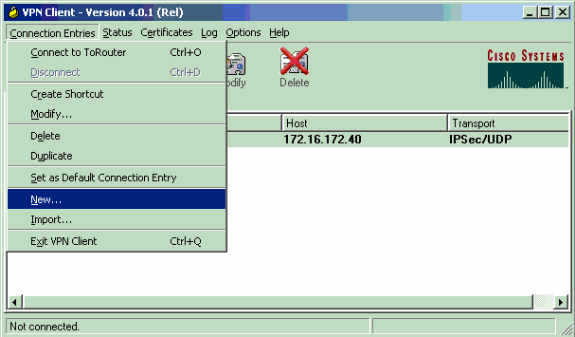

- #Cisco ip sec vpn client for mac
- #Cisco ip sec vpn client mac os
- #Cisco ip sec vpn client upgrade
- #Cisco ip sec vpn client software
An Application represents a service (e.g. An application is a service (e.g., VPN or web application) that you want to protect. Start by creating a LoginTC Application for your deployment.
#Cisco ip sec vpn client software
#Cisco ip sec vpn client upgrade
However, last week Apple did the free OS upgrade thing too ( OS X 10.9 “Mavericks”) and like little kids running after candy (it is Halloween, after all…) I and a bunch of other co-workers jumped right on it, and upgraded our machines. We have a variety of machines out there running OS X 10.7 (Lion) and 10.8 (Mountain Lion), and the built-in “Cisco IPsec” VPN Client has always worked well for us.
#Cisco ip sec vpn client mac os
We’ve always had a good experience with the Apple MacBook line (both Pro and Air) and more and more of our staff is electing to use an Apple notebook running Mac OS X. So, for now, we are officially not deploying or supporting either Windows 8, or 8.1, on our business machines (sorry, MSFT!) due to these VPN connection problems.Īt least they let us buy Apple products as well here. Between the lure of getting a Windows 8 that actually is usable on a regular desktop machine, and the upgrade price (free!), I took the early plunge and upgraded my Windows 8 machines (the aforementioned Surface Pro, and a regular laptop.) I was hoping that the VPN connection issue with the Metro Modern apps would be fixed (sadly, no) but imagine my horror when the new IE11 desktop browser also had connectivity issues! This is pretty much a deal-killer for us, as we are switching over to using SaaS for some LOB apps. Then came the free upgrade to Windows 8.1, which not only comes with the return of the Start button, but also the shiny new Internet Explorer 11. (It does leave me wondering how Microsoft has changed the Windows IP stack for the Modern apps, but that’s a black box to me since it’s a closed-source system.)

A support call to Microsoft on this issue got lost in the shuffle (too many internal transfers on their side, I guess) and I never pursued it, because all the desktop apps that we had to support were working fine over VPN. When I first found this problem when using the Cisco VPN Client on my new Surface Pro tablet, I then tried two other regular laptops running Windows 8, and they too had the same problem. However, we found an odd problem on the Windows 8 OS - when the Cisco VPN Client was connected, only the desktop (“classic”) applications had network connectivity, and not the new Modern ( nee “Metro”) apps. software to our Windows 7 64-bit, and now Windows 8 (which only comes in 64-bit) OS machines. We have been successfully deploying the 64-bit Cisco VPN Client 5. The first bump in the road came with the advent of Windows 8.

When we cut over from our old VPN3000 concentrators to ASA 5500 units a few years ago, all these IPsec clients continued to work, and all was well (and, importantly, the user base did not have to do or learn anything new to continue to be able to VPN.) Yes, we did also investigate An圜onnect when we cut over to the ASAs, but we found that Linux support was lacking, especially in the posture support we wanted to use, so the An圜onnect rollout was deferred.
#Cisco ip sec vpn client for mac
Oh, to be a Cisco IPsec VPN user these days… Now I know that we should get with the program and move to An圜onnect, since Cisco is EOL-ing the venerable Cisco VPN Client in 2014, but we have a large installed base, and since Cisco stopped making IPsec clients for Mac and Linux back in the 4.x days, we have been using the integrated VPN client on Mac OS X and the “vpnc” client on Linux on those respective platforms.


 0 kommentar(er)
0 kommentar(er)
